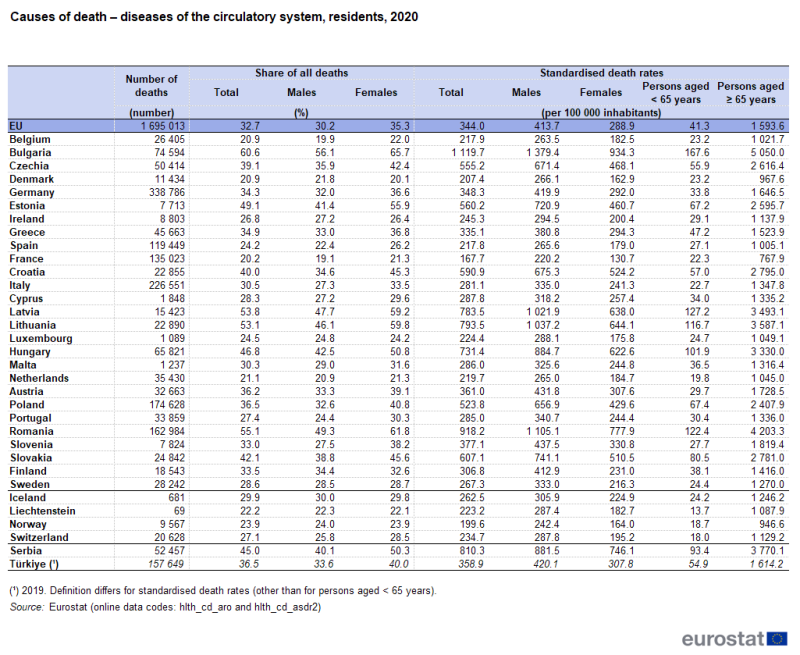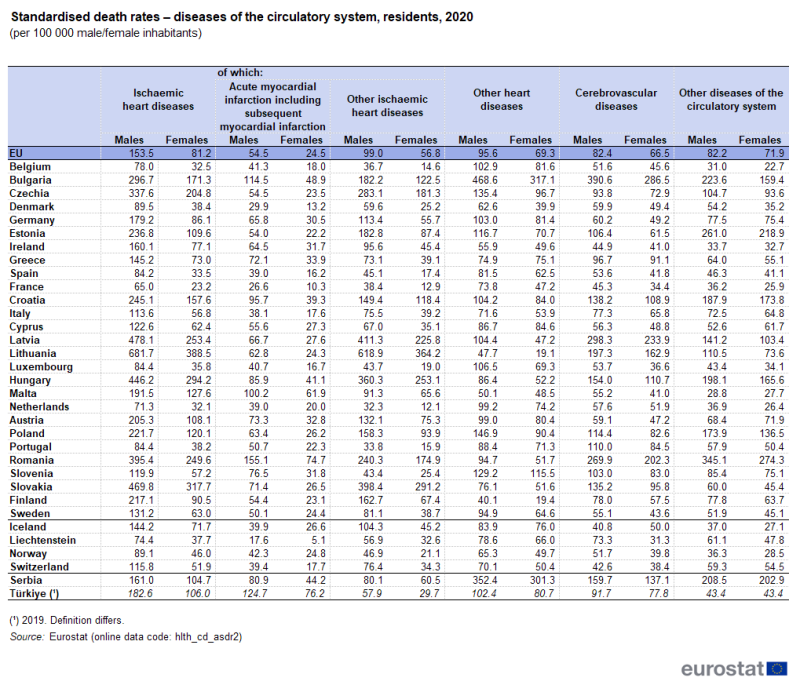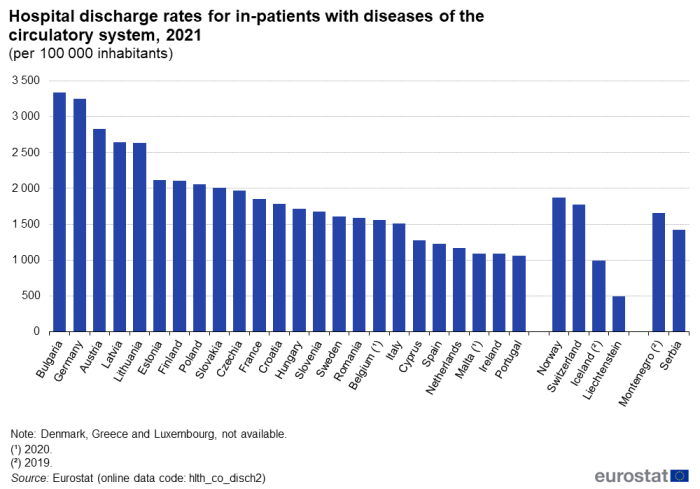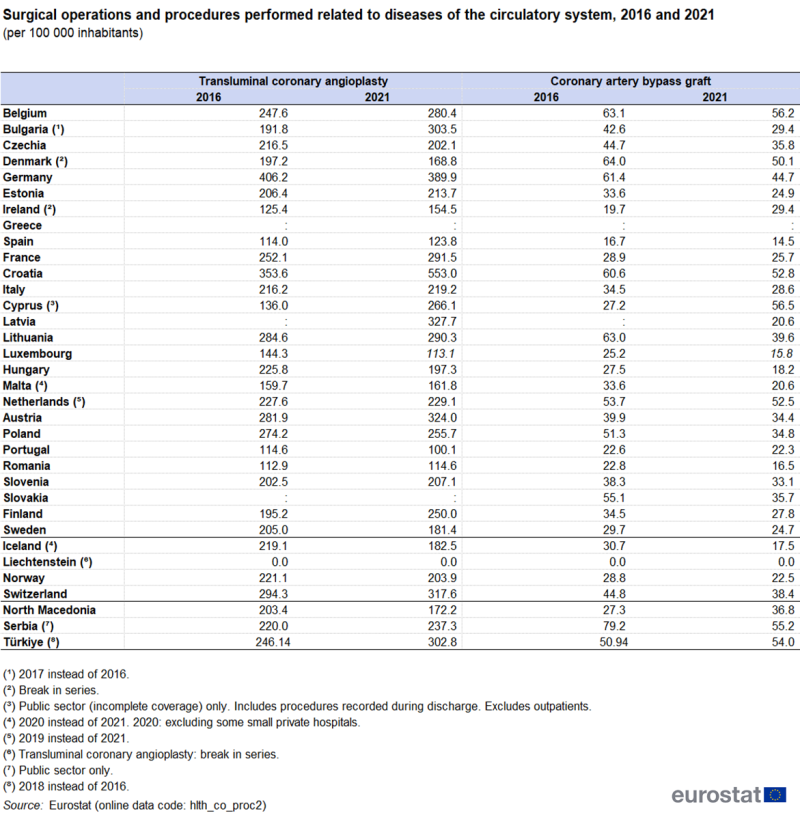Cardiovascular diseases statistics
Data extracted in September 2023.
Planned article update: September 2024.
Highlights
Diseases of the circulatory system are the main cause of death in the EU, responsible for almost one-third (32.7 %) of all deaths in 2020.
The standardised death rate for cerebrovascular diseases in 2020 in Bulgaria (which had the highest rate among the EU Member States) was 8.4 times higher than France (which had the lowest rate).
37 200 heart bypasses were conducted in Germany in 2021; this was more than double the number in any of the other EU Member States (17 400 were conducted in France).
Hospital discharge rates for in-patients with diseases of the circulatory system, 2021
This article presents an overview of European Union (EU) statistics related to cardiovascular diseases and focuses on cardiovascular health and mortality, as well as cardiovascular healthcare.
Cardiovascular diseases are the leading cause of death in the EU. They cover a broad group of medical problems that affect the circulatory system (the heart and blood vessels), often resulting from atherosclerosis, the abnormal build-up of plaque – that is made of, among other constituents, cholesterol or fatty substances – deposited on the inside walls of a person's arteries. Some of the most common diseases that affect the circulatory system include ischaemic heart disease (heart attacks) and cerebrovascular diseases (strokes).
This article is one of a set of statistical articles concerning health status in the EU which forms part of an online publication on health statistics.
Most of the data in this article relate to 2020 or 2021, although there are some data for earlier reference periods: as such, this article includes data that may have been impacted by the COVID-19 pandemic and its related restrictions. For this reason, particular attention should be paid when comparing the 2020 and/or 2021 data with data from earlier years.
In some EU Member States, healthcare systems were placed under intense pressure (particularly at the start of the pandemic) from an influx of patients with COVID-19. The pandemic also resulted in a range of knock-on effects including, among others, some services being curtailed/postponed due to the number of COVID-19 patients, staff shortages within hospitals and day care centres due to infection/quarantine procedures, and patients' hindered access to medical services due to their own infection/quarantine as well as lockdown or travel restrictions.
Full article
Deaths from cardiovascular diseases
There were 1.70 million deaths in the EU from diseases of the circulatory system
Diseases of the circulatory system place a considerable burden on healthcare systems and government budgets. Indeed, in 2020 there were 1.70 million deaths in the EU resulting from diseases of the circulatory system, which was equivalent to 32.7 % of all deaths. This percentage was considerably higher than the second most prevalent cause of death, cancer (malignant neoplasms; 22.5 % of all deaths).

Source: Eurostat (hlth_cd_aro) and (hlth_cd_asdr2)
Diseases of the circulatory system are one of the main causes of mortality in each of the EU Member States (as shown in Table 1): in 2020, they accounted for more than half of all deaths in Lithuania, Latvia and Romania, while the share was higher than two-fifths (60.6 %) in Bulgaria. By contrast, less than one-quarter of all deaths in Luxembourg, Spain, the Netherlands, Denmark, Belgium and France were caused by diseases of the circulatory system; France had the lowest share, at 20.2 %.
The largest gaps between the sexes were recorded in the three Baltic Member States as well as Romania, Croatia and Slovenia. In these EU Member States, the proportions of females dying from diseases of the circulatory system in 2020 were between 10.7 and 14.5 percentage points (pp) higher than those for males; these were the only EU Member States to report an imbalance of at least 10.0 pp. There were four EU Member States where a higher proportion of males (than females) died from diseases of the circulatory system: in Finland and Denmark, the shares of male deaths were 1.8 and 1.7 pp higher than those for females; smaller differences were observed in Ireland and Luxembourg.
Cyprus, the Netherlands, Malta and Belgium recorded the lowest gender differences in standardised death rates for diseases of the circulatory system
Standardised death rates are calculated as a weighted average of age-specific death rates and therefore improve comparability both over time and between countries. The EU's standardised death rate for diseases of the circulatory system was 344 deaths per 100 000 inhabitants in 2020, with the rate for males some 1.4 times as high as that for females.
Standardised death rates for diseases of the circulatory system were systematically higher for males than for females in 2020 across all of the EU Member States, although the differences between the sexes were relatively low compared with many other causes of death. The lowest absolute differences between males and females for standardised death rates for diseases of the circulatory system was recorded in Cyprus, at 61 deaths per 100 000 inhabitants; relatively small differences (just over 80 deaths per 100 000 inhabitants) were reported in the Netherlands, Malta and Belgium.
Deaths in younger ages can be considered as premature. Indeed, Table 1 shows that deaths from diseases of the circulatory system become more common at advanced ages. While this was true for the vast majority of causes of death, the standardised death rate for diseases of the circulatory system among those aged 65 years and over in the EU in 2020 was 39 times as high as the standardised death rate for persons aged less than 65 years; this can be compared with the same ratio for all causes of death, where the standardised death rate for those aged 65 years and over was 22 times as high as for persons aged less than 65 years. Note that the risk of females dying from diseases of the circulatory system before the age of 65 years was particularly low.
Within the EU as a whole, standardised death rates for males were consistently higher than those for females for all forms of diseases of the circulatory system
A more detailed analysis of causes of death for diseases of the circulatory system is presented in Table 2. EU standardised death rates for males in 2020 were higher than those for females for each of the six causes of death presented. For ischaemic heart diseases (codes I20–I25), the standardised death rate for males in the EU was 1.9 times as high as the corresponding rate for females. The difference between the sexes was less marked for other heart diseases (codes I30–I51), cerebrovascular diseases (codes I60–I69) and other diseases of the circulatory system (the remainder of codes I00–I99, not elsewhere covered).

(per 100 000 male/female inhabitants)
Source: Eurostat (hlth_cd_asdr2)
Some of the highest standardised death rates for ischaemic heart diseases were recorded in the Baltic Member States: Lithuania had the highest rate in 2020 for males (682 per 100 000 male inhabitants) and for females (389 per 100 000 female inhabitants), followed – in different orders for males and females – by Slovakia, Hungary, Latvia, Romania and Czechia. By contrast, the lowest standardised death rates for males and females were recorded in France, followed – again in different orders – by the Benelux Member States, Spain, Portugal and Denmark.
The standardised death rate for cerebrovascular diseases in Bulgaria was 8.4 times as high as the rate in France
In 2020, the highest standardised death rates for cerebrovascular diseases were recorded in Bulgaria, Latvia, Romania and Lithuania. By contrast, the lowest rates were recorded in France, Ireland and Luxembourg. As for all diseases of the circulatory system, there were large variations across the EU Member States in standardised death rates for cerebrovascular diseases in 2020, with the death rate in Bulgaria (where the highest rate was recorded) 8.4 times as high as that in France (where the lowest rate was registered).
Self-reporting of hypertensive diseases
The persistent effect of high blood pressure in arteries may lead to chronic failure of vital organs such as the heart, kidneys or brain. The data presented in Figure 1 are derived from the third wave of the European health interview survey (EHIS) which was conducted for 2019 and covered the population aged 15 years and over. The survey included questions on self-assessment of an individual's health and data on hypertension. Data are available for all EU Member States, Iceland, Norway, Serbia and Türkiye.

(%)
Source: Eurostat (hlth_ehis_cd1e)
A slightly higher proportion of females than males reported that they had hypertensive diseases
The highest shares of self-reported hypertensive diseases among the population aged 15 years and over were recorded in Croatia (37.3 %), Latvia (31.7 %), Hungary (31.5 %), Lithuania (29.9 %), Bulgaria (29.7 %) and Slovakia (28.4 %). By contrast, the lowest shares were recorded in Ireland (11.6 %), Romania (15.7 %), France (16.5 %) and the Benelux Member States (between 15.5 % and 17.4 %); Norway (15.1 %) and Türkiye (16.4 %) also reported relatively low shares.
An analysis by sex reveals that in most EU Member States a higher proportion of females than males reported that they had high blood pressure. In 2019, this gender difference was often considerable, especially in the Baltic Member States, Bulgaria and Romania (between 5.9 pp and 11.3 pp); this was also the case in Türkiye.
There were substantial age differences in the prevalence of hypertensive diseases, as the share of the population reporting high blood pressure increased substantially from the age group 25–34 years onwards. In the EU, 3.0 % of the population aged between 25 and 34 years reported hypertensive diseases, while this share rose to more than half (54.6 %) of the population among those aged 75 years and over.
Cardiovascular healthcare
Changes in the number of deaths associated with diseases of the circulatory system may occur for a variety of reasons, including among others the introduction of increased screening, new surgical procedures and forms of medication, as well as lifestyle changes for patients (for example, a reduction in the number of smokers).
The number of in-patients with diseases of the circulatory system discharged from hospitals across the EU was 8.6 million in 2021
Hospital discharges of in-patients treated for diseases of the circulatory system show a very large variation across the EU Member States. While absolute figures for discharges are clearly linked to the number of inhabitants in each country, the level of discharges may, among other influences, also reflect the incidence of each disease and differences in healthcare systems, for example, the balance between day care and in-patient treatment, or the availability of surgeons or hospital beds. In 2021, there were 8.6 million in-patients with diseases of the circulatory system discharged from hospitals across the EU (2020 data for Belgium and Malta; no recent data for Denmark, Greece or Luxembourg).
Bulgaria recorded the highest ratio per inhabitant of hospital discharges for in-patients with diseases of the circulatory system
Bulgaria and Germany both reported more than 3 000 in-patient discharges per 100 000 inhabitants among those treated for diseases of the circulatory system in 2021 (see Figure 2). Portugal, Ireland and Malta (2020 data) recorded the lowest ratios; they were the only EU Member States with fewer than 1 100 discharges per 100 000 inhabitants.

(per 100 000 inhabitants)
Source: Eurostat (hlth_co_disch2)
In 2021, across the EU, in-patients with diseases of the circulatory system (ICD codes I00–I99) spent a total of 69 million days in hospital (2020 data for Belgium and Malta; no recent data for Denmark Greece or Luxembourg). By far the highest share – more than one-third of the total (34.9 %) – was accounted for by in-patients in Germany, while Italy (12.1 %) and France (11.6 %) were the only other EU Member States recording double-digit shares[1].
In-patients with diseases of the circulatory system in Hungary spent, on average, 11.1 days in hospital per stay
When patients are treated for a disease of the circulatory system, they tend to spend a relatively lengthy period of time in hospital, reflecting the seriousness of some of these conditions. Table 3 presents an analysis of the average length of hospital stays for in-patients treated for a disease of the circulatory system in 2016 and 2021. The average length of stay in 2021 ranged from 4.1 days in Bulgaria up to 11.1 days in Hungary. Relatively lengthy average stays in hospital for in-patients treated for diseases of the circulatory system were also recorded in Austria and Estonia (10.4 and 10.3 days, respectively).

(days)
Source: Eurostat (hlth_co_inpst)
Among the EU Member States for which data are available (see Table 3), a majority (17 out of 24) recorded a fall between 2016 and 2021 in the average length of a hospital stay for people who were treated for a disease of the circulatory system. The largest decrease – 1.7 fewer days in hospital – was recorded in Finland, while decreases of 1.4 days and 1.2 days, respectively, were recorded in Hungary and Czechia; these were the only Member States to record falls of more than 1.0 days. By contrast, the average length of a hospital stay for people who were treated for a disease of the circulatory system rose by 1.3 days and 0.9 days in Latvia and Lithuania, respectively, with smaller increases in Estonia, Spain and Poland; there was no change in Ireland and Austria.
Table 3 also provides a more detailed analysis of the average length of hospital stays for in-patients treated for four different types of circulatory disease. On average, in-patients with cerebrovascular diseases (codes I60–I69) spent the highest number of days in hospital, followed by those treated for heart failure (code I50) or atherosclerosis (code I70).
Transluminal coronary angioplasty was a common form of intervention for patients treated for cardiovascular diseases
Table 4 provides an overview of the rates (number of surgical operations and procedures conducted in hospitals per 100 000 inhabitants) for two procedures related to cardiovascular diseases. The more common of the two was transluminal coronary angioplasty, which is a non-surgical procedure used to treat coronary arteries that have been narrowed; a deflated balloon is fed through blood vessels until it reaches the site of the blockage before inflating the balloon to open up the artery (allowing blood to flow normally).

(per 100 000 inhabitants)
Source: Eurostat (hlth_co_proc2)
Across the 25 EU Member States for which data are available, there were 1.1 million transluminal coronary angioplasty procedures conducted in 2021 (2020 data for Malta; 2019 data for the Netherlands; no recent data for Greece or Slovakia). Germany accounted for around 30 % (324 400 procedures) of the procedures that took place in the EU, which was considerably higher than in any of the other EU Member States; France and Italy were the only other Member States to report in excess of 100 000 procedures. Not only did Germany report the largest number of such operations, but also the second highest ratio when taking account of the size of its population (see Table 4): 390 transluminal coronary angioplasty procedures were performed in Germany per 100 000 inhabitants. The highest ratio was 553 per 100 000 inhabitants in Croatia. This procedure was least common in Portugal where it was conducted 100 times per 100 000 inhabitants, while relatively low ratios were also recorded in Luxembourg, Romania and Spain.
37 200 heart bypasses were conducted in Germany in 2021
Another relatively common operation for patients treated for cardiovascular diseases was a bypass anastomosis for heart revascularisation – also referred to as a heart bypass. This is a surgical procedure whereby arteries to the heart are replaced by blood vessels from another part of the body. In 2021, there were 139 000 heart bypass operations conducted across the EU (2020 data for Malta; 2019 data for the Netherlands; no recent data for Greece or Slovakia). Germany again recorded the highest number of operations (37 200) and had the sixth highest frequency when taking account of population size (44.7 per 100 000 inhabitants), behind Denmark, the Netherlands (2019 data), Croatia, Belgium and Cyprus (data for the public sector only). This procedure was least common in Spain, where it was performed on average 14.5 times per 100 000 inhabitants; it was also relatively uncommon in Luxembourg.
Source data for tables and graphs
Data sources
Key concepts
An in-patient is a patient who is formally admitted (or 'hospitalised') to an institution for treatment and/or care and stays for a minimum of one night in the hospital / other institution providing in-patient care. An in-patient or day care patient is discharged from hospital when formally released after a procedure or course of treatment (episode of care). A discharge may occur because of the finalisation of treatment, signing out against medical advice, transfer to another healthcare institution, or because of death.
The number of deaths from a particular cause of death can be expressed relative to the size of the population. A standardised (rather than crude) death rate can be compiled which is independent of the age and sex structure of a population: this is done as most causes of death vary significantly by age and according to sex and the standardisation facilitates comparisons of rates over time and between countries.
Healthcare resources and activities
Statistics on healthcare resources (such as personnel and medical equipment) and healthcare activities (such as information on surgical operations and procedures and hospital discharges) are documented in the background article Healthcare non-expenditure statistics – methodology which provides information on the scope of the data, its legal basis, the methodology employed, as well as related concepts and definitions.
For surgical operations and procedures, the International Classification of Diseases – clinical modification (ICD-9-CM) is used.
- Operations on the cardiovascular system (35–39)
- Transluminal coronary angioplasty (36.01, 36.02 and 36.05)
- Bypass anastomosis for heart revascularisation (36.1)
For hospital discharges and the length of stay in hospitals, the International Shortlist for Hospital Morbidity Tabulation (ISHMT) is used to classify data from 2000 onwards; Chapter IX covers diseases of the circulatory system.
- Hypertensive diseases (0901)
- Angina pectoris (0902)
- Acute myocardial infarction (0903)
- Other ischaemic heart disease (0904)
- Pulmonary heart disease and diseases of pulmonary circulation (0905)
- Conduction disorders and cardiac arrhythmias (0906)
- Heart failure (0907)
- Cerebrovascular diseases (0908)
- Atherosclerosis (0909)
- Varicose veins of lower extremities (0910)
- Other diseases of the circulatory system (0911)
For country specific notes on these data collections, please refer to the annexes at the end of the national metadata reports accessible from links at the beginning of the European metadata report.
The Healthcare non-expenditure statistics manual provides an overview of the classifications, both for mandatory variables and variables provided on voluntary basis.
Health status
Self-reported statistics covering the health status of the population for a range of chronic diseases are provided by the European health interview survey (EHIS). This source is documented in more detail in the background article European health interview survey – methodology which provides information on the scope of the data, its legal basis, the methodology employed, as well as related concepts and definitions. The data presented in this article refer to the share of the population aged 15 years and over reporting that they had been diagnosed by a medical doctor with high blood pressure (hypertension) occurring in the 12 months prior to the survey.
Causes of death
Statistics on causes of death provide information on mortality patterns, supplying information on developments over time in the underlying causes of death. This source is documented in more detail in the background article Causes of death statistics – methodology which provides information on the scope of the data, its legal basis, the methodology employed, as well as related concepts and definitions.
Causes of death are classified according to the European shortlist (86 causes), which is based on the International Statistical Classification of Diseases and Related Health Problems (ICD). Chapter IX of the ICD covers diseases of the circulatory system.
- I00–I02 Acute rheumatic fever
- I05–I09 Chronic rheumatic heart diseases
- I10–I15 Hypertensive diseases
- I20–I25 Ischaemic heart diseases
- I26–I28 Pulmonary heart disease and diseases of pulmonary circulation
- I30–I52 Other forms of heart disease
- I60–I69 Cerebrovascular diseases
- I70–I79 Diseases of arteries, arterioles and capillaries
- I80–I89 Diseases of veins, lymphatic vessels and lymph nodes, not elsewhere classified
- I95–I99 Other and unspecified disorders of the circulatory system
Symbols
Tables in this article use the following notation:
| Value in italics | estimate or provisional data; |
| Value is : | not available. |
Context
Statistics concerning cardiovascular diseases are of particular significance because these diseases are the principal cause of death within the EU. Increased prevention, especially for heart disease and strokes, has resulted in decreases across most EU Member States concerning the number of people who face disability, reduced quality of life and premature death. Nevertheless, cardiovascular diseases continue to touch the lives of millions of Europeans each day.
According to the World Heart Federation, modifiable risk factors for cardiovascular diseases include hypertension, diabetes, obesity, hypercholesterolemia, tobacco and related products use, stress, sleep disorders, sedentary lifestyle, harmful alcohol consumption and unhealthy eating.
Cardiovascular diseases is one of the five main strands covered by the European Commission's Healthier together – EU non-communicable diseases (NCD) initiative. The initiative was launched in December 2021 and aims to support EU countries in identifying and implementing effective policies and actions to reduce the burden of major NCDs and improve citizens' health and well-being.
Direct access to
Online publications
Causes of death
Healthcare activities
Methodology
General health statistics articles
Atlas
News releases
- Health (t_hlth), see:
- Causes of death (t_hlth_cdeath)
- Death due to other ischaemic heart diseases, by sex (tps00119)
- Death due to ischaemic heart diseases by NUTS 2 regions (tgs00059)
- Health (hlth), see:
- Health status (hlth_state)
- Self-reported chronic morbidity (hlth_srcm)
- Persons reporting a chronic disease, by disease, sex, age and educational attainment level (hlth_ehis_cd1e)
- Self-reported chronic morbidity (hlth_srcm)
- Health care (hlth_care)
- Health care activities (hlth_act)
- Hospital discharges - national data (hlth_hosd)
- Length of stay in hospital (hlth_hostay)
- Operations, procedures and treatment (hlth_oper)
- Health care activities (hlth_act)
- Causes of death (hlth_cdeath)
- General mortality (hlth_cd_gmor)
- Causes of death - deaths by country of residence and occurrence (hlth_cd_aro)
- Causes of death - standardised death rate by NUTS 2 region of residence (hlth_cd_asdr2)
- General mortality (hlth_cd_gmor)
Manuals and guidelines
Metadata
- Causes of death (SIMS metadata file – hlth_cdeath_sims)
- European health interview survey (ESMS metadata file – hlth_det_esms)
- Healthcare non-expenditure statistics (ESMS metadata file – hlth_res_esms)
Notes
- ↑ For more information please see this table: hlth_co_hosday.